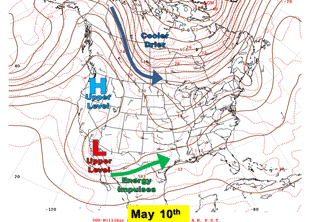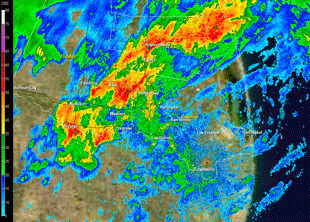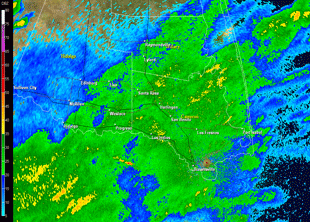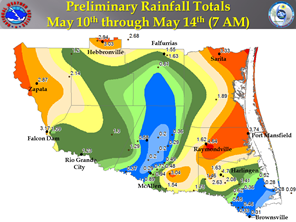|
Event Summary
A series of weak upper level disturbances ejected from the base of a flat trough of low pressure that meandered in northwest Mexico between May 10th and 14th, before ejecting into the southern Plains on the 15th (below). Each disturbance produced some rainfall across the Rio Grande Valley, South Texas Brush Country, and Rio Grande Plains. The heaviest rains fell late on the 10th through early morning of the 11th, as outflows from strong to severe storms across the Big Bend surged into the Rio Grande Plains. For the second time in two weeks, rains flooded Laredo and Nuevo Laredo; the rapid rainfall rate overnight on May 10th/11th left "Laredo Morning Times article on deaths and homelessness from May 10/11 Flooding" 4 persons dead and thousands homeless in Nuevo Laredo. Torrential rains and some hail smacked Zapata County shortly after midnight on the 11th; the storms continued into Starr County before weakening in Hidalgo County, then reintensified in southeast Hidalgo County and Cameron County. The initial surge of rain dropped between 1 and 2.5 inches in Zapata County, and 2 to 3 inches in a band from near Weslaco through Harlingen, Raymondville, and Port Isabel (top right).
The initial thrust of rain was followed by additional rainfall each evening and overnight across different parts of Deep South Texas through very early on May 15th. Steady light rain with embedded thunder returned late on the 11th (bottom right) and early on the 12th as energy provided lift to the north of the front which had passed early on the 11th. Additional light rain fell in Cameron County during the evening of the 12th, with heavier rain and some thunder across the ranchlands of Jim Hogg and Starr County. Most of the Valley stayed dry on the 13th and early on the 14th, but a band of moderate rain slid from the foothills of the Sierra Madre near Monterrey into southwestern Starr and Zapata County. One final band of showers and thunderstorms passed across the Rio Grande Plains and Ranchlands north of the RGV from near midnight to the wee hours of May 15th as the persistent upper level system lifted into the southern Plains, taking the final disturbance with it.
The additional rainfall across formerly parched sections of the Rio Grande Plains and Ranchlands added up to a general 2 to 4 inch total for the period; some spots in southern Jim Hogg County may have touched 6 inches for the two rain periods that began on April 27th. While the Rio Grande Plains and Ranchlands of Zapata, Jim Hogg, Starr, and some of Brooks County benefited, the "dead zone" of southeast Starr and western Hidalgo County missed the action – AGAIN. Less than two inches fell from Mission to La Joya and towns in between; these locations have been among the lowest rain totals across the region since the dry period began in October 2010.

Animation of pressure systems in the "jet stream" level (around 18,000 feet in this case) between May 10th and 15th, 2013. Disturbances ejecting from the persisting area of low pressure in northern Mexico produced rain for some of the Rio Grande Valley/Deep South Texas region through May 15th. The system itself weakened and lifted into the Southern Plains on the 15th, taking the rain and cool weather with it (click to enlarge). |

Animation of 0.5° base reflectivity from NWS Brownsville/Rio Grande Valley, between 4 and 5 AM on May 11th. Thunderstorms re–intensified across Cameron County, dropping between 2 and 3 inches in some locations west of Harlingen (click to enlarge).

Animation of 0.5° base reflectivity from NWS Brownsville/Rio Grande Valley, between 1 and 2 AM on May 12th. Steady light rain, with embedded moderate rain and some lightning and thunder, covered eastern Hidalgo and Cameron County and dropped up to 0.25 inch in some areas (click to enlarge).

Preliminary rainfall map for period May 10th through 7 AM May 14th. Additional rainfall from midnight through early morning on May 15th is not included (click to enlarge).
How Now, Drought?
The rains of late April and early May were beneficial, but far from necessary to alleviate the drought, which had lasted for more than two years. For western Hidalgo and southeastern Starr County, the lower rain totals ensured Exceptional (D4, worst level) would continue as dry, hot conditions appeared to close May 2013. Cameron and Willacy County were unable to improve beyond the Extreme (D3) level, despite pockets of more than 6 inches of rain. The most "improvement" was across the Rio Grande Plains and Ranchlands of Jim Hogg, northern Starr, and Zapata County, where the locally estimated and measured 4 to 6 inches accounted for 25 to 33 percent of the annual rainfall and made a slight, though temporary, dent in the drought, improving from Exceptional to Severe (D2) in just a few weeks. Unfortunately, reservoir recovery was limited at Falcon, which remained around one quarter of conservation; larger Amistad reservoir had fallen to one half its level in May 2013 compared with May 2012. The US Drought Monitor as of May 14th is shown at the end of this article.
|